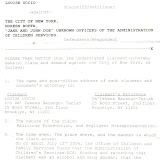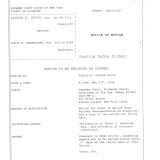So IMO what they are about to do is allow the children to stay at home but the "child protective" industry will now stalk each and every family with services they don't need?
God help us, and let us enjoy our children, help the States figure out ANOTHER way to bring in funding LEAVE OUR FAMILIES ALONE!
The fires of abuse
By Catherine Mosbacher, John Castle and Jim Hine
We all agree that preventing child abuse is better than dealing with its aftermath. It also turns out to be a lot cheaper.
According to a new economic impact analysis by Prevent Child Abuse America, child abuse and neglect cost the United States nearly $104 billion a year, equal to $1,000 for every American family.
The direct costs are for hospitalization, immediate mental healthcare, child welfare services and law enforcement. The indirect costs are for special education, juvenile delinquency, long-term mental healthcare, criminal justice and lost productivity. Of course, the pain and suffering of abused and neglected children are incalculable.
When we ran the state agency mandated to protect children, however, we were frustrated that prevention programs were always the last funded and the first cut, leaving us like firefighters too busy extinguishing fires to prevent fires.
Texas has a lot of fires to fight. In 2006, nearly 68,000 Texas children were confirmed victims of abuse or neglect. Nationwide, that number jumps to 1 million.
Not every case of child maltreatment can be prevented, but many are preventable through services and support that help families.
However, government primarily funds after-the-fact protection rather than before-anything-happens prevention.
According to a just-released study by Kids Are Waiting, an initiative of the Pew Charitable Trusts, the federal government strictly limits the percentage of federal funds that states can spend on prevention. The vast majority of federal dollars can be spent on children only after they enter foster care.
The report urges Congress to reform the way it funds child protection to help support the continuum of services needed by at-risk children and families. Although foster care is a crucial safety net, we strongly agree that states need to be able to spend federal funds flexibly to provide services that help more children safely live with their own families. And if we spent more on prevention, eventually we would save on foster care.
Unfortunately, though, the issue isn't just how we spend our money but how much money we spend. In the long run, prevention saves money; in the short run, it requires a surge of spending because we still have to fight today's blazes while we prevent tomorrow's fires.
If federal funding streams were redesigned to allow states to spend more federal dollars on prevention, it could be a catalyst for increasing state funding. In 2003, during the most recent fiscal crisis, the Texas Legislature significantly cut the state budget for prevention.
Since then the Legislature has restored some money and launched one new program: the Nurse-Family Partnership, in which a nurse visits homes of low-income, first-time parents and their children.
A study by the Prevention Research Center found that the work of the Nurse-Family Partnership resulted in a 48 percent reduction in child abuse and neglect. Other studies saw improved prenatal health, fewer childhood injuries, fewer subsequent pregnancies, and increased maternal employment among the program's participants.
In addition, the state is implementing programs designed to keep families together rather than bring children into foster care, but funding is limited, and too few families can be served. The Legislature also has asked for a long-term child abuse and prevention plan, but an effective plan would require additional funding. In the current state budget, prevention programs are getting 3.5 percent less than before the legislative cuts in 2003.
Texas needs to renew its commitment to a prevention strategy. Child maltreatment is too costly a problem to keep doing what we are doing. If Texas invested in prevention now, we are confident that the dividends paid by children growing up to become productive citizens would yield a very rich return.
Catherine Mosbacher, John Castle and Jim Hine are on the board of the Center for Public Policy Priorities. They served together at the Texas Department of Protective and Regulatory Services.
Subscribe to:
Post Comments (Atom)























No comments:
Post a Comment